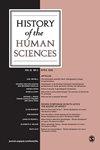种族图解:塞缪尔·乔治·莫顿的《美国各各他》和对人类学这一新兴领域的定义之争
IF 0.5
2区 历史学
Q2 HISTORY & PHILOSOPHY OF SCIENCE
引用次数: 0
摘要
在18世纪的最后几十年到19世纪中叶之间,人类学史上发生了一些至关重要的事情。这是一种通过比较测量对“人类”进行分类的体质人类学的出现。新贸易的一个中心工具是图表。图表本质上是关于物体内部和物体之间的关系,它成为定义人类群体及其相互关系的手段——最后一点是单基因论者和多基因论者之间的争论。詹姆斯·考尔斯·普里查德(James Cowles Prichard)是比较历史方法的支持者,他在1813年开创性的《人类物理史研究》(Studies Into the Physical History of Man)中可以不使用图像,但第三版在1836年至1847年间分为五卷,用“种族类型”和头骨(包括图表)进行了丰富的说明。发生的事情是我为塞缪尔·乔治·莫顿(Samuel George Morton)详细参与的一个过程,他在美洲Crania americana(1839年)和埃及Crania aegyptiaca(1844年)收集并分发了人类头骨作为石版画。除了这些纸头骨,还详细介绍了如何通过一组线条来观察它们,以及如何将它们的各个部分相互联系以及与其他类型的部分联系起来。因此,根据约翰·弗里德里希·布鲁门巴赫和彼得·坎珀的作品,Crania在建立我所说的种族图解方面发挥了关键作用——这一图解与乔赛亚·诺特和乔治·格莱登为纪念莫顿而写的《人类类型》(1854年)一起公开政治化。本文章由计算机程序翻译,如有差异,请以英文原文为准。
A diagrammatics of race: Samuel George Morton's ‘American Golgotha’ and the contest for the definition of the young field of anthropology
Between the last decades of the 18th century and the middle of the 19th century, something of paramount importance happened in the history of anthropology. This was the advent of a physical anthropology that was about the classification of ‘human races’ through comparative measurement. A central tool of the new trade was diagrams. Being inherently about relations in and between objects, diagrams became the means of defining human groups and their relations to each other – the last point being disputed between the monogenists and the polygenists. James Cowles Prichard, a proponent of the comparative historical approach, was able to do without images in his pioneering Researches Into the Physical History of Man of 1813, but the third edition, which appeared in five volumes between 1836 and 1847, was richly illustrated with ‘ethnic types’ and skulls, including diagrams. What was happening is a process I engage with in detail for Samuel George Morton, who collected and distributed human skulls as lithographs in Crania americana (1839) and Crania aegyptiaca (1844). Along with the paper skulls travelled detailed instructions of how to look at them through a set of lines and to set their individual parts in relation to each other as well as to those of other types. Drawing on Johann Friedrich Blumenbach and Peter Camper, the Crania thus played a pivotal role in establishing what I call a diagrammatics of race – a diagrammatics that became overtly political with Types of Mankind (1854), which was written in Morton's honour by Josiah Nott and George Gliddon.
求助全文
通过发布文献求助,成功后即可免费获取论文全文。
去求助
来源期刊

History of the Human Sciences
综合性期刊-科学史与科学哲学
CiteScore
1.60
自引率
11.10%
发文量
31
审稿时长
>12 weeks
期刊介绍:
History of the Human Sciences aims to expand our understanding of the human world through a broad interdisciplinary approach. The journal will bring you critical articles from sociology, psychology, anthropology and politics, and link their interests with those of philosophy, literary criticism, art history, linguistics, psychoanalysis, aesthetics and law.
 求助内容:
求助内容: 应助结果提醒方式:
应助结果提醒方式:


